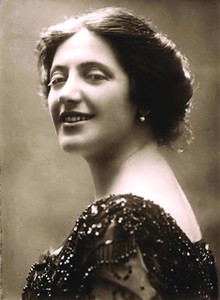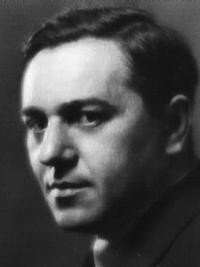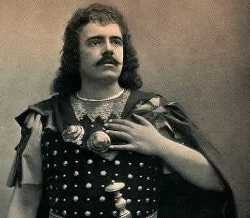
Salomea (Solomia) Amvrosievna Krushelnitskaya (Salomea Kruszelnicka) |
Salomea Kruszelnicka

Even during her lifetime, Salomea Krushelnitskaya was recognized as an outstanding singer in the world. She had an outstanding voice in terms of strength and beauty with a wide range (about three octaves with a free middle register), a musical memory (she could learn an opera part in two or three days), and a bright dramatic talent. The singer’s repertoire included over 60 different parts. Among her numerous awards and distinctions, in particular, the title of “Wagnerian prima donna of the twentieth century.” The Italian composer Giacomo Puccini presented the singer with his portrait with the inscription “beautiful and charming Butterfly”.
Salomeya Krushelnytska was born on September 23, 1872 in the village of Belyavintsy, now the Buchatsky district of the Ternopil region, in the family of a priest.
Comes from a noble and ancient Ukrainian family. Since 1873, the family moved several times, in 1878 they moved to the village of Belaya near Ternopil, from where they never left. She started singing from a young age. As a child, Salome knew a lot of folk songs, which she learned directly from the peasants. She received the basics of musical training at the Ternopil gymnasium, where she took exams as an external student. Here she became close to the musical circle of high school students, of which Denis Sichinsky, later a famous composer, the first professional musician in Western Ukraine, was also a member.
In 1883, at the Shevchenko concert in Ternopil, the first public performance of Salome took place, she sang in the choir of the Russian conversation society. In Ternopil, Salomea Krushelnytska got acquainted with the theater for the first time. Here, from time to time, the Lvov theater of the Russian conversation society performed.
In 1891, Salome entered the Lviv Conservatory. At the conservatory, her teacher was the then famous professor in Lviv, Valery Vysotsky, who brought up a whole galaxy of famous Ukrainian and Polish singers. While studying at the conservatory, her first solo performance took place, on April 13, 1892, the singer performed the main part in G. F. Handel’s oratorio “Messiah”. The first operatic debut of Salome Krushelnytska took place on April 15, 1893, she performed the role of Leonora in the performance of the Italian composer G. Donizetti “The Favorite” on the stage of the Lviv City Theater.
In 1893 Krushelnytska graduated from the Lvov Conservatory. In Salome’s graduation diploma, it was written: “This diploma is received by Panna Salomea Krushelnitskaya as evidence of an art education received by exemplary diligence and extraordinary success, especially at a public competition on June 24, 1893, for which she was awarded a silver medal.”
While still studying at the conservatory, Salomea Krushelnytska received an offer from the Lviv Opera House, but she decided to continue her education. Her decision was influenced by the famous Italian singer Gemma Bellinchoni, who at that time was touring in Lviv. In the autumn of 1893, Salome leaves to study in Italy, where Professor Fausta Crespi became her teacher. In the process of studying, performances at concerts in which she sang opera arias were a good school for Salome. In the second half of the 1890s, her triumphant performances on the stages of theaters around the world began: in Italy, Spain, France, Portugal, Russia, Poland, Austria, Egypt, Argentina, Chile in the operas Aida, Il trovatore by D. Verdi, Faust » Ch. Gounod, The Terrible Yard by S. Moniuszko, The African Woman by D. Meyerbeer, Manon Lescaut and Cio-Cio-San by G. Puccini, Carmen by J. Bizet, Elektra by R. Strauss, “Eugene Onegin” and “The Queen of Spades” by P.I. Tchaikovsky and others.
February 17, 1904 at the Milan theater “La Scala” Giacomo Puccini presented his new opera “Madama Butterfly”. Never before has the composer been so sure of success … but the audience booed the opera indignantly. The celebrated maestro felt crushed. Friends persuaded Puccini to rework his work, and to invite Salome Krushelnitskaya to the main part. On May 29, on the stage of the Grande Theater in Brescia, the premiere of the updated Madama Butterfly took place, this time triumphant. The audience called the actors and the composer to the stage seven times. After the performance, touched and grateful, Puccini sent Krushelnitskaya his portrait with the inscription: “To the most beautiful and charming Butterfly.”
In 1910, S. Krushelnitskaya married the mayor of the city of Viareggio (Italy) and the lawyer Cesare Riccioni, who was a connoisseur of music and an erudite aristocrat. They were married in one of the temples of Buenos Aires. After the marriage, Cesare and Salome settled in Viareggio, where Salome bought a villa, which she called “Salome” and continued to tour.
In 1920, Krushelnitskaya left the opera stage at the zenith of her fame, performing for the last time at the Naples Theater in her favorite operas Lorelei and Lohengrin. She devoted her further life to chamber concert activity, performing songs in 8 languages. She has toured Europe and America. All these years until 1923 she constantly came to her homeland and performed in Lvov, Ternopil and other cities of Galicia. She had strong ties of friendship with many figures in Western Ukraine. Concerts dedicated to the memory of Taras Shevchenko occupied a special place in the singer’s creative activity. In 1929, the last tour concert of S. Krushelnitskaya took place in Rome.
In 1938, Krushelnitskaya’s husband, Cesare Riccioni, died. In August 1939, the singer visited Galicia and, due to the outbreak of World War II, was unable to return to Italy. During the German occupation of Lviv, S. Krushelnytska was very poor, so she gave private vocal lessons.
In the post-war period, S. Krushelnytska began working at the Lviv State Conservatory named after N.V. Lysenko. However, her teaching career barely started, almost ended. During the “cleansing of personnel from nationalist elements” she was accused of not having a conservatory diploma. Later, the diploma was found in the funds of the city historical museum.
Living and teaching in the Soviet Union, Salomeya Amvrosievna, despite numerous appeals, for a long time could not obtain Soviet citizenship, remaining a subject of Italy. Finally, having written a statement about the transfer of her Italian villa and all property to the Soviet state, Krushelnitskaya became a citizen of the USSR. The villa was immediately sold, compensating the owner for a meager part of its value.
In 1951, Salome Krushelnitskaya was awarded the title of Honored Art Worker of the Ukrainian SSR, and in October 1952, a month before her death, Krushelnitskaya received the title of professor.
On November 16, 1952, the heart of the great singer stopped beating. She was buried in Lviv at the Lychakiv cemetery next to the grave of her friend and mentor, Ivan Franko.
In 1993, a street was named after S. Krushelnytska in Lviv, where she lived the last years of her life. The memorial museum of Salomea Krushelnytska was opened in the singer’s apartment. Today, the Lviv Opera House, the Lviv Musical Secondary School, the Ternopil Musical College (where the Salomeya newspaper is published), the 8-year-old school in the village of Belaya, the streets in Kyiv, Lvov, Ternopil, Buchach are named after S. Krushelnytska (see Salomeya Krushelnytska Street ). In the Mirror Hall of the Lviv Opera and Ballet Theater there is a bronze monument to Salome Krushelnytska.
Many artistic, musical and cinematographic works are dedicated to the life and work of Salomea Krushelnytska. In 1982, at the A. Dovzhenko film studio, director O. Fialko shot the historical and biographical film “The Return of the Butterfly” (based on the novel of the same name by V. Vrublevskaya), dedicated to the life and work of Salomea Krushelnitskaya. The picture is based on the real facts of the singer’s life and is built as her memories. The parts of Salome are performed by Gisela Zipola. The role of Salome in the film was played by Elena Safonova. In addition, documentaries were created, in particular, Salome Krushelnitskaya (directed by I. Mudrak, Lvov, Most, 1994) Two Lives of Salome (directed by A. Frolov, Kyiv, Kontakt, 1997), cycle “Names” (2004), documentary film “Solo-mea” from the cycle “Game of Fate” (director V. Obraz, VIATEL studio, 2008). March 18, 2006 on the stage of the Lviv National Academic Opera and Ballet Theater named after S. Krushelnitskaya hosted the premiere of Miroslav Skorik’s ballet “The Return of the Butterfly”, based on facts from the life of Salomea Krushelnitskaya. The ballet uses the music of Giacomo Puccini.
In 1995, the premiere of the play “Salome Krushelnytska” (author B. Melnichuk, I. Lyakhovsky) took place in the Ternopil Regional Drama Theater (now the academic theater). Since 1987, the Salomea Krushelnytska Competition has been held in Ternopil. Every year Lviv hosts the international competition named after Krushelnytska; festivals of opera art have become traditional.





